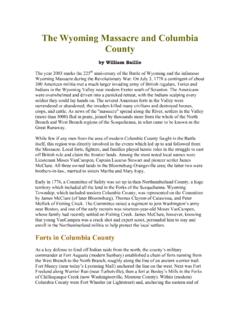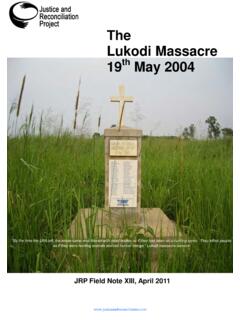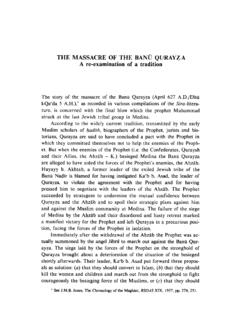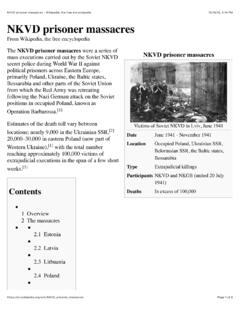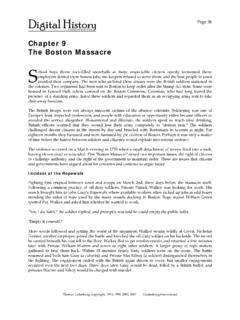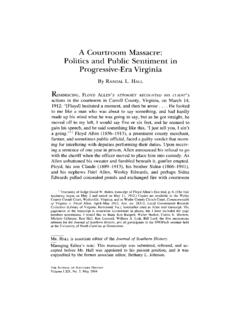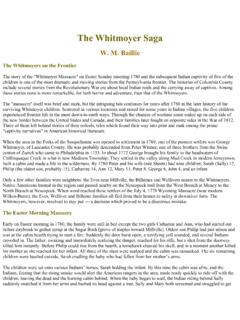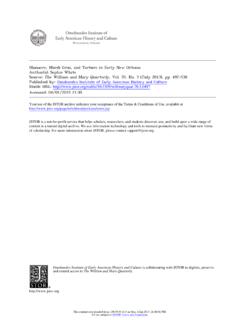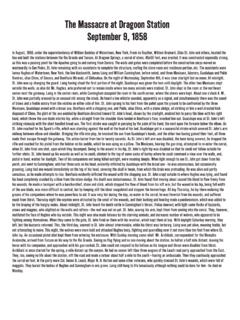Transcription of Massacre and Murder in the Susquehanna Valley: The Lee ...
1 33 Massacre and Murder in the Susquehanna valley : The Lee Massacre and Pine Creek Indian Murders by Kathy K. Swope Although difficult to imagine today, two hundred and fifty years ago the busy corridor along Route 15 in Union County was the edge of Pennsylvania s frontier. Local native inhabitants and settlers struggled to live peaceably, members of both groups committing atrocities in the process. One local incident began a chain of events that stretched over nearly a decade, and resulted in the recently elected President of the United States, George Washington, intervening under the newly passed Indian Trade & Intercourse Act of 1790. During the summer of 1782, although peace talks had begun, the battle for American independence continued. In Northumberland County (Union County would not be formed until 1813), Fort Augusta (Sunbury), under the command of Colonel Samuel Hunter provided protection from attacks by Indian allies of the British Military. John Lee Among the local militiamen who volunteered to protect the region, was Major John Lee who had settled in the area now known as Winfield, being among the first settlers following the Treaty of Stanwix (1768).
2 He acquired about 300 acres in April of 1769 from the Penn Proprietors, naming it Lee s Adventure. The stone house that still stands along the creek in Winfield is believed by many to be the site of Lee s homestead. In addition to that acreage, records show that in September of 1770 John Lee hired James Wilson to survey a 38-acre tract of land. Wilson states, he commenced at a white oak at a survey on which Ludwig Derr now lives. This places the 38 acres near Lewisburg, probably in the area of Bucknell University, and raises the question as to whether the white oak referenced is the famous Witness Tree that still stands near the entrance to the Lewisburg Cemetery. 34 The stone house in Winfield believed to be the site of the Lee Massacre Lee was a respected citizen, as noted in the extant record of his public service. He was appointed Overseer of the Poor of Buffalo Township (which was comprised of all of what is now Union County) in 1773, the first election following the formation of Northumberland County.
3 Also in 1773, Lee was issued a tavern license for the first tavern in what is now Winfield. It is important to recognize that the occupation of tavern keeper was considered a highly respected position in that time period. Taverns were key gathering centers of the community, providing access to the news as travelers would stop to rest their horses and share a meal along with the latest information from other towns gathered along the way. The 1775 Buffalo Township tax assessment for Lee charges him for 20 acres of cleared land, one cow, ten sheep and one servant. This suggests he amassed some significant wealth, based on the fact that of the 246 heads of households in Northumberland County at the time, only twelve households had servants. 35In August of 1776, John Lee along with Charles Gillespie were commissioned as good and true men, to produce powder and lead at Harris Landing (now known as Harrisburg) for the newly organized militia. The militia was organized for Northumberland County; Lee was chosen to serve as a 2nd Major of the 1st Battalion, and was later promoted to 1st Major.
4 On December 1, 1776, the Committee of Safety, which was rooted in the Sons of Liberty and organized the militia during the Revolution, offered a $ bounty for each man from Northumberland County who would march with the Associators (members of the Committee of Safety) to join Washington s army. The volunteers selected Lee to serve as their Captain before leaving and were assigned to the Twelfth Regiment of the Pennsylvania Line, with Colonel James Potter s 2nd Battalion. James Potter (1729-1789) was a veteran of the French & Indian War, who led the construction of three stockade forts in Central Pennsylvania, including one near the present site of Woodward. He would go on to serve as the fourth Vice President of Pennsylvania (1780 & 1781). In 1782 he received a commission as a major general, and that same year lost the election for the Presidency of Pennsylvania (what we know today as Governor) to John Dickenson. Potter served as one of the representatives to the Pennsylvania Constitutional Convention and Potter County is named for him.
5 Following his service in the Revolution, Lee and the other members of the militia returned to protect the settlers on the frontier. He continued to be active in public affairs, and was assessed in 1781 for 150 acres in Buffalo Township and 600 acres in Augusta Township. Lee was tax assessor for Buffalo Township at the time of his death in 1782. The Lee Massacre There are several accounts of the event that occurred about noon on August 12, 1782, known as the Lee Massacre , but the most contemporaneous is from a letter dated August 16, 1782, written by a Gentleman at Sunbury that appeared in the September 14, 1782 issue of a Philadelphia newspaper, the Independent Gazetteer. It was a warm Monday afternoon, a group of sixty to 36seventy native inhabitants entered Major Lee s house while he was dining with his family, friends, and neighbors. According to the letter s account, the natives took him and his family, and part of two other families to the number of thirteen people from the house.
6 The gentleman continues, declaring if they would submit, they should not be hurt; they acquiesced and proceeded as prisoners, walking about a half mile, when the savages, without any hesitation, murdered seven of them, who were tomahawked and scalped in the most shocking manner. The letter ends the recounting of the event by telling us, a party of volunteer inhabitants upon hearing of the affair, went to their scene and groans of the dead and dying people, were enough to have melted any heart of flesh. The writer also provides us with a sense of context from the perspective of the settlers by further explaining, Since the last spring, no less than sixty two of our people have been butchered by the Indians; and this hath been the practice for several years past. He references the numbers of settlers who have left the area, and the probable need to evacuate the area without some force to protect them. His pleas for protection include a request for financial assistance, and some dried meat and biscuit from the government to support an expedition to attack the native inhabitants, and he suggests a reduction in unnecessary officers and extravagant salaries as a source of funding.
7 The gentleman ends his letter stating that, the cries of the innocent call up to heaven for vengeance and redress against them. He adds as a final note that, But we despair of any aid. Our country purposes to put in no fall grain, and many are now awaiting for places to remove. Clearly, settlers were leaving the area due to a fear for their safety, and the Lee Massacre appears to have generated a new level of concern. The seven who were murdered appear from records to be John Lee, his wife, and two young sons, an old gentleman named John Walker, and Mrs. Claudius Boatman and one of her daughters. Other accounts documented years later offer some additional information and in some cases conflicting reports with regard to some of the details of the event. As with all things, time and oral history have obscured some of the facts, but historian John Meginness wrote in 1857 an account of the incident that told 37of a young woman named Katy Stoner, (perhaps the daughter of Gustavus Stoner of Northumberland) who escaped up the stairs and concealed herself behind the chimney, where she remained undiscovered in the Lee household that fateful day.
8 Meginness also adds to the information from an account that was supplied by an A. H. McHenry, whose father, Henry McHenry, was a member of the expedition that followed the native inhabitants after they fled the scene of the Lee Massacre . Mrs. Lee, her infant daughter Eliza, two young daughters, Sarah and Rebecca and an older son, Thomas were led away as captives. They were taken on the Great Path which roughly followed today s Route 15 north to Allenwood and there bore left, roughly onto today s Route 44, then over the Bald Eagle Mountain to Lock Haven. One of Lee s sons, Robert, was returning home just as the natives were leaving his home with his family captive. He fled to Fort Augusta (Sunbury) and raised the alarm. Colonel Hunter gathered a party of about 20 men and headed to the area of Lee s homestead. They arrived to find those still living to be writhing in agony. Lee and Miss Boatman were still alive and were transported to Fort Augusta, where Lee later died.
9 Miss Boatman, although scalped, survived, and lived to an old age. Colonel Hunter and his party continued in pursuit of those taken captive, coming in sight of them above Lycoming Creek. Mrs. Lee was bitten on the ankle by a rattlesnake while going through the mountains and she was unable to walk any further. One of the native inhabitants, noting Colonel Hunter s rapidly approaching party, shot her in the head and dashed the small child against a tree, before fleeing hastily with Thomas, Sarah and Rebecca still captive. The small child, believed to be Eliza, was shaken but not injured. Hunter pursued until they reached Antes Gap, where Hunter decided it was unwise to continue due to the possibility of an ambush and the exhaustion of the members of the expedition. They returned to Fort Augusta, burying Mrs. Lee, and stopping to bury the dead at the scene of the Massacre along the way. Lee s oldest son, Robert, spent several years trying to secure the release of his young brother from the native captivity, eventually succeeding in obtaining 38his freedom.
10 His two sisters, Rebecca and Sarah, escaped and returned home within a short time after their capture. In 1797, Robert Lee obtained releases from each of his siblings in order to deed the property in Winfield to Abraham Ire (Eyer). Among the dead was an old gentleman named John Walker (1706-1782). In an assessment that is dated between 1778 and 1780 he is taxed in Buffalo Township, apparently in the neighborhood of John Lee. According to a 1937 letter written by a Walker descendant, Alice Walker who was born in 1855, John Walker lived in Harrisburg prior to the Revolution. She states that John Walker was a Dutchman who had several sons, three are remembered by history, Benjamin, William and Henry. The Walker Brothers The Walker brothers, although young at the time of their father s death, grew up to be respected citizens of the Pine Creek, a few miles above what is now Jersey Shore, Lycoming County, but at that time was part of Northumberland County. On June 27, 1790, eight years after the Lee Massacre , the Walker brothers were among a number of men at Stephenson s Tavern that was located near the mouth of Pine Creek.



